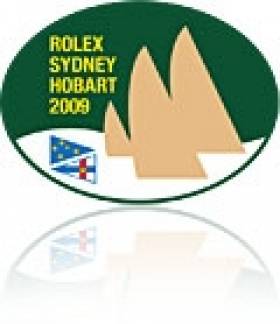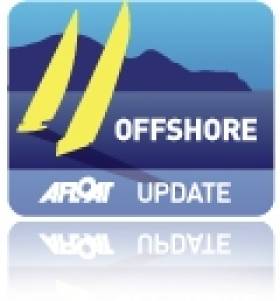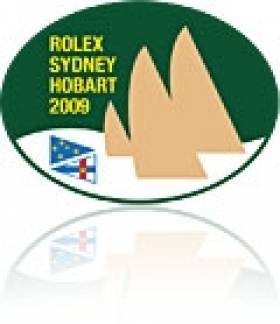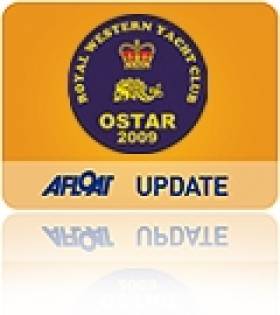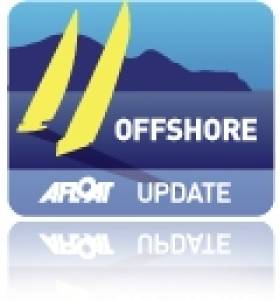Displaying items by tag: Barry Hurley
For Irish Offshore Racing Sailors, 'Tis The Season To Be Sailing To Hobart
#rshyr – Tasmania is a medium-sized island in the Great Southern Ocean which is sheltered to the west only by South America. And as Tasmanians reckon skinny little New Zealand doesn't really provide a proper lee, they'll tell you their island is also sheltered to the east only by South America. So although it is at the same latitude in the south as Bordeaux in southern France is in the north, Tasmania's weather conditions – particularly the winds – can be much more extreme than they are in Bordeaux.
For sure, this lovely island can have some beautiful summer weather. But equally, it can serve up some very demanding sailing conditions. Thus the annual 628-mile Rolex Sydney-Hobart Race inevitably brings the fleet into increasingly hostile seas the further south they progress down much of the course. And the Bass Strait between Australia and Tasmania is a notoriously rough bit of water which has claimed lives in this event.
But then the twist in the tail is the final ten or so miles from the Iron Pot up the narrowing and increasingly flukey Derwent Estuary to the finish at the Hobart waterfront. This concluding crawl can test any sailor's sportsmanship as he or she sees a good position, hard earned over hours and days on a very rough sea, wafted away in calm spots and fickle zephyrs. Indeed, some hardened Hobart race veterans reckon the real contest finishes not even at the Iron Pot, but rather as you enter Storm Bay in the approaches to the Derwent Estuary, saying that it's just a lottery thereafter. But despite such criticisms, the race is one of sailing's great events. W M Nixon takes a look at this year's 70th staging of the classic, which starts in traditional style on Sydney Harbour in less than six days time.
If the annual Rolex Sydney-Hobart Race didn't exist, then world sailing would have to invent it. But happily, it's there already for our absorption and enjoyment. And in 2014 for its 70th staging, it's more relevant than ever in an era of instant global communication. When we remember that much more than half of humanity lives in the Northern Hemisphere and many of them are now in the depths of winter, the fact that there's this glorious and accessible sailing spectacle all ready to roll on screens worldwide, just as we're finally sated with Christmas and all its trappings, is a sanity-preserver for anyone interested in boats and sport.
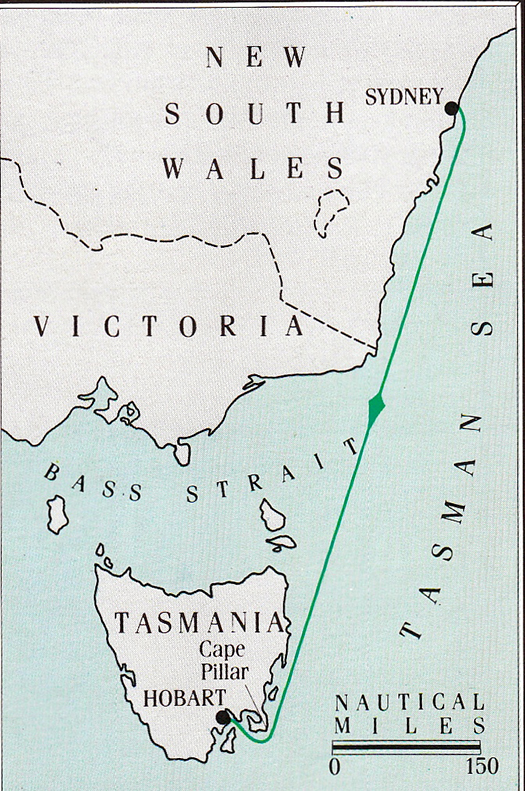
The great race's 628 mile course takes the competitors ever deeper towards the Southern Ocean with every mile sailed.
Of course there's Irish involvement in it at a specific level, with two boats in particular carrying our special interest. But at a more generous level, anyone who has the slightest interest in sailing cannot but be fired up by the wonder of an event in which some of the most advanced hundred footers in the world are swept up in a contest in which they will not only be in cut-throat competition with each other for line honours, but at the end, when all the calculations have been done, for dyed-in-the-wool offshore racing enthusiasts the real competition will be for the Tattersall's Cup, the hugely prestigious trophy for the overall handicap winner.
With 117 expected starters of all sizes from 33ft to 100ft, as the race gets under way each boat will have its own ideal set of conditions and circumstances to suit crew hopes. But as the contest continues, there'll be those who start to emerge in the leading group on handicap, and by the time they're in the final approaches, it is usually whittled down to about a dozen boats or even less which are in there with a shout for the Tattersall's.
But the line honours race for the Illingworth Cup – named in honour of the great British offshore racing skipper and innovator John Illingworth who first suggested the race in 1945 and won it too – now that's a different animal altogether. It's a real death or glory battle. And there's something specially entertaining and attractive about a no-holds-barred contest between boats you could like a lot, just at the time when the word is that the current flotilla of Volvo Round the World Racers may not be very likeable boats at all.
For we hear that the Volvo 65s are twitchy beasts, and not really fun to sail. To have a boat which turns round and looks at you is unfortunate. To have a boat which lies on its back and waves its legs in the air is unfortunate. But a boat that does both....? Oscar Wilde's Lady Bracknell said everything about such a situation.
So we'll return with relief to the crazy guys with the glorious big boats at the front of the fleet in the race to Hobart, for after the Volvo 65s, they're like a breath of fresh air. This is definitely not the territory of careful accountants and penny-pinching save-a-dime boatbuilding. We're looking at the stuff of legend. And the people's favourite has to be the veteran Wild Oats XI, marvellously campaigned by Mark Richards and his team of all the talents with the full support of the veteran owner Bob Oatley (86), whose wine brand of Wild Oats – one of many business interests – doesn't suffer any image problems at all when his boat of the same name wins yet again.
They talk of the Reichel Pugh designed super-slim Wild Oats XI as a "beloved old boat", but in truth she has been so continuously modified that you'd be hard put to say just what is original. The word is they've made her waterlines even narrower up forward – she used to be skinny, but now she's anorexic. As for last year's secret ingredient, the horizontal hydrofoil which, when deployed to lee, reportedly improved performance by up to 4% by making the boat better able to carry sail, for this year's race they tried making it even longer, such that it didn't entirely retract into the housing. But it seems that with a bit sticking out permanently on the weather side, it created more fuss than it was worth, so it has been shortened back to disappear entirely when not in use.
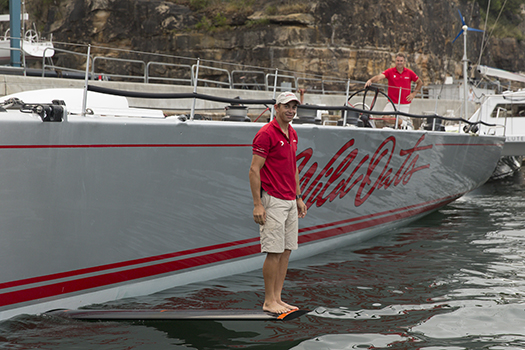
Wild Oats XI has so many bits and pieces sticking out of her hull that she has been compared to a Swiss Army Knife. This is skipper Mark Richards standing on the horizontal hydrofoil which, when deployed on the lee side, gives sufficient lift to significantly improve sail-carrying power. However, it has been shown that it has to be completely retractable into its housing when on the weather side, otherwise it causes unacceptable turbulence.
This conclusion on the downside of making the hydrofoil even longer emerged from some serious heavy weather sailing by Wild Oats off Sydney recently, when she was getting her final pre-Hobart race test and crew training. Heading back to port, with only about a quarter of the mainsail set in a very big wind, the silver arrow was making up to 33 knots. That will be food for thought for the four other hundred footers, the most challenging of which is of course Jim and Kristy Hinze Clark's new Comanche, just out of the wrappings, a hundred foot of total racer with Kenny Read as skipper.
The new girl on the block. American Jim Clark and his Australian wife Kristy Hinze Clark will debut their new hundred footer Comanche in the Rolex Sydney-Hobart 2014.
The same Kenny Read endeared himself to the Irish sailing community during the first Volvo visit to Galway five years ago, when he exited the dock somehow managing to look cool wearing a Paddy Hat that no-one else would be seen dead in. The boy is still busy, as he's worldwide president of North Sails, while his current main commitment afloat is to campaign the very extreme Comanche to the limit, with the Rolex-Sydney Hobart Race 2014 the first outing for real.

God be with the days.....five years ago, Kenny Read endeared himself to the people of Ireland by managing to look cool in this hat while exiting Galway Docks during the Volvo stopover. Photo: Failte Ireland/David Branigan
The hundred footers did have their first encounter a couple of weeks ago with the CYCA Solas Big Boat Challenge in Sydney Harbour, but racing boats this size in such relatively restricted water gives a somewhat skewed picture. Nevertheless the very experienced tacticians on Wild Oats still managed to finish first, as they did last year, but it was Comanche second quite a bit clear of Anthony Bell's Perpetual Loyal.
Once upon a time, Perpetual Loyal was very well known in Ireland, but that was in 2011 when she was George David's Rambler 100, and upside-down off West Cork. Until Comanche's appearance, Perpetual Loyal was reckoned the potentially fastest hundred footer of them all if she just could get enough wind in the right direction. But now the hundred footer field is wide open as a number of them have been undergoing major modifications of the kind you might expect to see on model yachts, but not on thirty metre hulls.

Can you see the join? The entire aft half of Rio 100 is entirely new, thanks to several months of major surgery in Auckland.
Thus the former Lahana, now American-registered, owned by Manouch Moshayedi and re-named Rio 100, simply had her entre aft half cut off, and replaced with a new wider stern section. Just like that. But you ain't heard nuthin' yet. The irrepressible Syd Fischer, shaping up to do his 50th Sydney-Hobart at the age of 87, decided that the hull of his hundred foot Ragamuffin needed some mods. A lot of mods. So he has just kept the deck and rig, but cut off the original hull, and replaced it with a new one from the same designer, Andy Dovell.
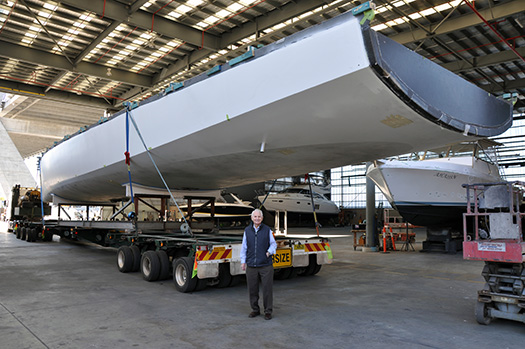
The incredible Syd Fischer, a sprightly 87-years-old, with the entirely new Andy Dovell-designed hull before it was fitted under the deck and rig of his previous hundred footer Ragamuffin.
So if next time you're on Sydney Harbour and a peculiar-looking hundred foot motorboat comes tootling past with a slightly lost air to her, you'll know why. She could swear that once upon a time she had a deep keel and a great big mast. But she's out and motoring about because there's no way Australians will let a redundant hundred foot hull go to waste. Meanwhile, the new raceboat hull has barely had time for testing, but we're assured all will be well, and the something old, something new Ragamuffin 100 will be there on the line raring to go against Wild Oats, Comanche, Perpetual Loyal and Rio 100 in the battle for line honours.
But as old Hobart hands will tell you, the real race is almost something else altogether. You'll have noticed that in mentioning the Solas Big Boat Challenge, we only talked of line honours. But it has an equally important IRC element as well, and two weeks ago the winner was Matt Allen's Carkeek 60 Ichi Ban, with Gordon Maguire the main man.

She may seem a plump girl by comparison with some other boats, but Matt Allen's Carkeek 60 Ichi Ban has been winning races, including the Solas Big Boat Challenge 2014. For the Rolex Sydney-Hobart 2014, skipper Gordon Maguire will be joined by ace Irish-born navigator Adrienne Cahalan.
And Ichi Ban's challenge in the Hobart race is even more Irish, as the Allen-Maguire team have linked up with Offaly-born Adrienne Cahalan to be navigator. One of Australia's top women sailors in almost any role, her navigational skills are legendary, and in the 2013 race she was navigating the 55ft Wedgetail to such good effect approaching the Tasmanian coast that they held the IRC lead, only for it all to come tumbling about their ears with a dismasting, which is hardly the navigator's fault.
So this time to Hobart, Ichi Ban really does have the dream team aboard. And though we still wonder if she's not just a little too plump in her waterlines forward to have that real cutting edge, the boat's results over the past year suggest that she has what it takes, and if the cards fall her way at all, she'll be clear to win.
Looking again at the top ten IRC boats in 2013, it's significant that apart from the freak presence of the hefty Swan 82 Nikata at 7th overall, only Ichi Ban at 8th overall was over 50ft long. The rest of the top ten were all 50ft or under, and the outstanding design was the evergreen Cookson 50, represented by both the overall winner Victoire (Darryl Hodgkinson), and the ninth placed Pretty Fly III (Colin Woods).
We in Ireland know well of the New Zealand-built Farr Cookson 50's brilliance through Chieftain (Ger O'Rourke), which later became Adrian Lee's Lee Overlay Partners, thus putting the Fastnet overall win of 2007 and the Caribbean 600 overall win of 2009 on the Cookson 50 winner-board before Victoire added the Sydney-Hobart win in 2013. It's some going for a design which first saw the light of day more than ten years ago.
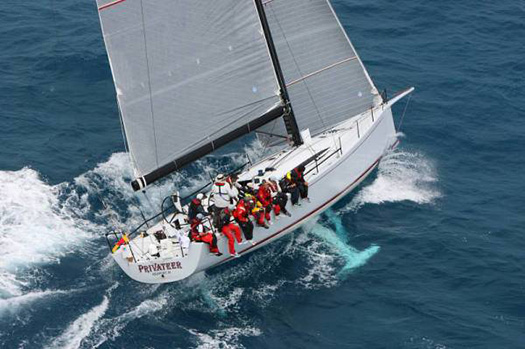
Privateer is one of the evergreen Cookson 50s, which have been consistently successful in the world's top offshore races for a decade
But as 2013's results show, doing well in the Sydney-Hobart has a huge element of horses for courses to it, and in 2010 the very new First 40 from Beneteau made a prodigious debut by taking first and second overall. They're still a very competitive boat, so not surprisingly there's five of them shaping up for the race to Hobart, and this is where the most direct Irish involvement comes, as Barry Hurley and his team have linked up with co-owner Mathew Vadas to put the beef in the crew of the First 40 Breakthrough. [Click to read Barry Hurley's preparations for this third successive Sydney–Hobart Race – Ed]
The same linkup saw Breakthrough take eighth in Class and 29th Overall in the 2013 race, but this time round Barry Hurley ships on board with the added experience of second overall and first in class in October's Middle Sea Race. With him to show that the boat is indeed sailing under the Dublin Bay Sailing Club colours are Catherine Halpin and Kenny and Alexander Rumball. And the word on the waterfront is that a shore support team not entirely unconnected with the Irish National Sailing School will be an enthusiastic presence in Sydney on December 26th. We look forward to hearing from them. Meanwhile, Happy Christmas everyone.
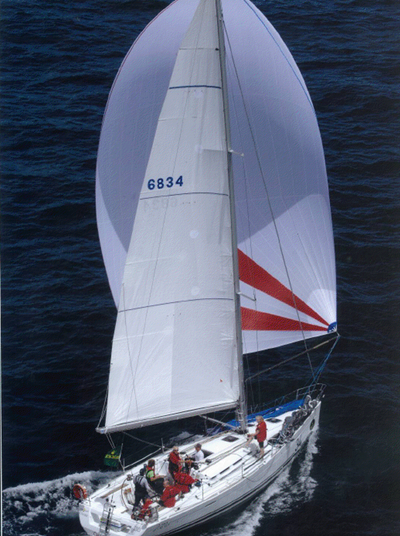
The First 40 Breakthrough will be racing under Dublin Bay Sailing Club colours in the Rolex Sydney-Hobart race 2014, starting December 26th
Ireland To Sail in 70th Sydney–Hobart Yacht Race on December 26th
#rshyr – Ireland will be racing in the Rolex Sydney Hobart Yacht Race that marks its 70th edition this year, a momentous achievement for an offshore race that has become an international classic since its creation in 1945.
Ireland's Barry Hurley, who was part of a winning crew in October's Middle Sea Race is heading for the Cruising Yacht Club of Australia's Sydney Hobart Yacht Race. More details on the Irish entry in the race here.
Over the course of its proud history, the Rolex Sydney Hobart has paid homage to feats of bravery, extraordinary seamanship, speed and endeavour; has witnessed adversity and overcome tragedy; and has attracted a diverse cross-section of people to contest this nautical rite of passage. The race has been conquered by both 30-ft Corinthian-crewed boats and imperious, professionally-sailed 100-ft Maxi yachts.
Rolex has sponsored the competition since 2002, an integral part of its triumvirate of 600-nm offshore classics also comprising the United Kingdom's Rolex Fastnet Race (first run in 1925) and the Rolex Middle Sea Race (dating back to 1968). The values of adventure, courage, determination, discovery and sportsmanship set these offshore races apart from other yacht-racing events, and reflect a rigorous sporting ethos with which Rolex is privileged to be associated.
Make a race of it
The original idea of sailing from Sydney to Hobart, Tasmania, was launched by members of the Cruising Yacht Club of Australia (CYCA) shortly after its creation in 1944. Originally planned as a cruise, history recounts that John Illingworth, a British Navy officer residing in Sydney who had competed in the Fastnet in 1937, only agreed to take part if the other participants would "make a race of it", which they did. Nine yachts – ranging from 30 to 63-ft – took part in that first race.
Compared to the sophisticated, high-tech equipment and information systems available to the crews in 2014, 1945 was a vastly different era: in the post-war years, materials were scarce and rudimentary. Safety measures were minimal by today's standards, navigation was by sextant and compass, some crews did not possess functioning radios and therefore remained ignorant of weather reports and storm warnings.
When Illingworth's yacht Rani arrived in Hobart on the evening of 1 January 1946, her crew had no idea of her position in relation to the rest of the fleet. Assuming his boat was last to arrive, Illingworth was astounded to learn that his boat, the second smallest yacht in the fleet, had beaten the competition as fastest finisher. Rani also proved to be the race's overall winner. As the first recipients of the prestigious Tattersall's Cup, both Illingworth and Rani have become two of the event's legendary characters.
Tales from that heroic, almost curious, first race inspired others to take part. It fast became a tradition and has taken place between Christmas and New Year every year since.
Challenging, compelling
Seventy years on, many of the values instilled by the race's founders are still prominent; the sense of adventure, the Corinthian spirit, the camaraderie, dedication, respect for the elements and the competition. Many of the values prevalent in offshore racing form part of Rolex's ethos and explain its close association with this component of the sport.
A sense of adventure and a determination to be the best have been integral to the history of Rolex. In 1926, Rolex invented the Rolex Oyster, the world's first waterproof wristwatch. To prove his invention, Rolex founder Hans Wilsdorf equipped Mercedes Gleitze with an Oyster when she swam the English Channel a year later. The Rolex watch emerged from more than 10 hours in the water in perfect working order. Through their robustness, reliability, precision and functions, Rolex watches are tools of human achievement. They have endured climbing the world's highest mountain (Everest, 1953) and greatest ocean depth (Challenger Deep, 1960). They offer freedom from many constraints, allowing attention to focus on the main objective and the obstacles to be overcome, all the while aware of the vital notion of time.
Overcoming challenges and pushing boundaries explain part of the Rolex Sydney Hobart's status as a classic. For most crews, the chances of winning are extremely low. The attraction lies in the many unknowns of racing 628 nautical miles, the exhilaration and the sense of accomplishment at the finish. The race has earned a fearsome reputation, justified by the route touching some of the toughest open waters on the planet. In 1998, a severe storm, similar in strength to a low-class hurricane, led to the sinking of five yachts and the deaths of six sailors in the Bass Strait. The response of the organizers was proactive: new safety measures and regulations were introduced immediately after the disaster.
Briton Mike Broughton, a regular competitor and highly experienced navigator, whose first encounter with offshore racing was the infamous 1979 Fastnet Race, has observed many finishes over the years: "There's a look in people's eyes when they get to Hobart; quite often it is bloodshot and tired, but there is an elation at having done the race. It means a great deal, a huge amount."
Competitors are drawn to the raw nature of testing themselves against the elements. The mix of hard physical challenges is well documented, and for some sailors there is fear to overcome; something Broughton is adept at explaining: "We start in Sydney where it is lovely and sunny, 26 degrees, and we're going on a yacht race. But, you turn right [south] out of the Heads [the exit from Sydney Harbour, giving onto open sea] and often on the first night you are straight into a southerly bringing much colder winds from Antarctica and the sea state can be pretty brutal. Fear is not something you want to talk about. It is kept in the back of your mind, but it is one of the challenges of this race."
Drawn to compete
The great names and characters who have competed have helped fuel interest and the legend. Throughout the years the race has attracted politicians, business tycoons, sporting legends and, naturally, the cream of sailing talent. Notable recipients of the Tattersall's Cup include British statesman Sir Edward Heath with Morning Cloud in 1969, media mogul Ted Turner and American Eagle in 1972 and American sailing stalwart John Kilroy and Kialoa II in 1977.
The first boat to finish the Rolex Sydney Hobart always receives a rapturous welcome in Hobart. Line honours winners have included famous participants like American business giant Larry Ellison with Sayonara in 1995 and 1998, French sailing legend Eric Tabarly and Pen Duick II in 1967, and German entrepreneur Hasso Plattner and Morning Glory in 1996. Over the past decade, the contest has been dominated by Australian wine producer Bob Oatley's Wild Oats XI, a 100-ft Maxi which has twice broken the race record and claimed seven line honours titles in the process.
Worldwide attention
In Australia, one of the world's most sport-conscious nations, the Rolex Sydney Hobart has carved out for itself a permanent place in the calendar of unmissable events. In Sydney itself, the start of the race draws crowds to the harbour during the height of summer and the end-of-year festivities. Its annual start the day after Christmas, the ever-growing folklore, the spectacle: all have an impact and the result is dramatic. "It would not be the same growing up in Australia not watching the Boxing Day Test [cricket match] followed by the start of the Rolex Sydney Hobart, one of the great sailing challenges," says Phil Waugh, the Australian rugby union star and crew member of the first boat to finish the 2011 Rolex Sydney Hobart.
Hundreds of thousands of people pack the foreshore and Sydney Harbour is congested with big boats, little boats, kayaks, dinghies. Everyone in Sydney who can get on the water does so, the rest watch from shore or join the international television audience. No other sailing event in the world commands such avid attention, bringing a nation to near standstill for an hour.
It is a remarkable fact that start and finish are both regarded as something to witness; something you would tell your friends: 'I was there'. Few sailing events in the world can truly claim to cross the boundary between niche sport and major attraction. In 2011, when the first two yachts to finish were separated by three minutes, 10,000 spectators were estimated to be on the dock in festive Hobart captivated by the moment.
Human endeavour
"The greatest lesson this race can teach you is humility. It doesn't matter what background you come from, what wealth you have or don't have, the sea doesn't discriminate. It's the purest thing a human can do: be propelled by the sea and wind to reach a destination," says Sean Langman who has competed in the race over 20 times.
Non-sailors may find it difficult to understand the intricacies of yacht racing and the handicap system that means the first to finish is not necessarily the winner. What they do comprehend is enterprise, courage and adventure. The element of personal challenge that inhabits this race plays a full part in attracting wider appreciation. "I keep coming back because I love the race: I love the challenge, the preparation, and I love the battle against the ocean and the battle against the other yachts. My grandfather sailed this race, my father sailed this race, it has passed down through generations. I feel like I am part of it – I hope later in my life my son will do it too," says Peter Merrington, who has finished the Rolex Sydney Hobart over ten times.
It is a challenge which has endured and enticed for 70 years and will continue to do so. Like climbing Everest or diving to the world's deepest point, the Rolex Sydney Hobart is a true test of human endeavour.
The 2014 Rolex Sydney Hobart commences at 13:00 AEDT on Friday 26 December.
Third Sydney–Hobart Race Beckons For Irish Offshore Sailor Barry Hurley
#rshyr – This will be my third year in a row racing 'Breakthrough' (a First 40) in the Rolex Sydney Hobart Race writes offshore sailor Barry Hurley, Afloat's October Sailor of the Month. 'Breakthrough' is a Sydney based boat owned and skippered by Mathew Vadas. He sails it with a local crew for much of the year, but I work with him remotely all year round in preparation for the Race. Come December, I normally bring some European sailors South for the event to complement the skillset of the regular crew based on experiences throughout the year. It's an arangement that works well for everybody.
Following the very stormy race last year and a busy local season, much of the boat's sail wardrobe was reaching end of life, so for this years campaign we have had the opportunity to plan a new sail inventory from scratch. We started working on this last January while last years race was fresh in our minds. By now many of the new sails have arrived and the boat is sailing regularly to gather data in different conditions which we can use to tweak the design of the last few sails in the coming weeks. We have also upgraded the standing rigging and headsail foil to reduce weight and windage up high since the majority of the competition in our class all have carbon masts and we used to suffer in heavier airs as a result. Right now we're going through all the iteratons to make sure that all the changes made actually work together, and that we haven't introduced any unexpectded weaknesses in varying conditions. So far so good though, and the boat seems to be responding as expected.
Sometimes it's the tiny little things that count however. Last year during the tough condtions crossing the Bass Straits we discovered that when the hull flexed in one particular manner it would somehow cause several of the lockers down below to open and eject their contents all over the boat. It didn't really slow us down, but it made a lot of unnessary work tidying and cleaning the inside of the boat, which was no easy task in itself in those conditions. It was a distraction, and could have caused somebody to slip and hurt themselves. Needless to say the locker catches have now all been made stormproof. My experience has taught me that it's this sort of attention to detail in boat prep that makes all the difference in an offshore race, but often the weaknesses don't show themselves until the boat gets pushed beyond it's normal routine. After crossing the Bass Strait four times on this boat we're only just getting to the stage where we feel like we're ready and fully prepared to keep pushing hard in every eventuality.

Breakthrough racing upwind in the Tasman Sea. The Tasman River and the tide play a huge role, tactics change by the hour. Photo: Rolex
Apart from the final selections which are still coming together, it is looking like three of the crew will have done two prior iterations of the race with me, and another three have completed the race once with me before now. Continuity of crew helps immensely, and just like with the boat it's only after sailing many hard miles that you really appreciate and understand everybody's individual strengths. Myself and my good friend, Ben Hunter (Australia), will manage tactics and navigation between us. Ben sails the boat regularly and is invaluable in providing feedback during the year as well as organising all the logistics of modifications as our plans evolve. The two watches will be led by Adam Carpenter (Australia) and Kenny Rumball (Dublin), both of whom are extremely talented, experienced sailors, each with the right attitude to lead a watch and keep pressing the boat through the more difficult times. One unusual aspect of this race is the enormous amount of HF radio communications mandated by the race organisers. Catherine Halpin (Dublin) will distil hours of mandatory fleet radio chatter at the chart table into a few snippets of information that can help drive tactical decisions. She will also stand watch as a bowman opposite race veteran Tom Guy (Australia). With myself, Kenny, and Adam doing most of the driving, owner Mathew Vadas will concentrate on sail trim for one watch, opposite Alexander Rumball (Dublin).
Many of the tactical decisions for the race can be made during the week in advance, with the East Australian Current (of 'Finding Nemo' fame) quite well computer modelled, and the Southern Ocean weather systems excellently forecast. This makes life easier because your inital preferred route need only be impacted by the actions of your competitors and the need for defence or offence. That said, rounding Tasman Island where the weather is volatile, the Tasman River and the tide play a huge role, and the preferred tactics change by the hour. The last day of the race, sailing up that river is often the most tactically challenging, just when physical and mental strength are running low. It is also where the race is regularly won and lost. By now I have several cheat sheets prepared and laminated, reminding me from previous experiences what to expect and where losses and gains could happen at each state of the tide on the way up the river. This makes decisions easier and quicker allowing us to keep pushing for boatspeed and concentrating on our performance againt the boats around us. I like to think that I've figured out the fast way up the river by now, but history shows that the race often comes down to a little bit of luck with the weather over that last fifty miles. It is a piece of water that throws something new at you every time you sail it, and it's never an easy day on the water.
With Mathew being in his 70th year this year, as well as it being the 70th Rolex Sydney Hobart Race, a safe arrival in Hobart will mark one of our primary goals being acheived. Having improved our performance each year to date with this boat, and having taken massive learnings each time, it's fair to say we hope to at least cause worry to those on the leaderboard in our IRC class. Due to its almost straight line trajectory, this race can sometimes favour boats at either end of the rating spectrum. Being one of the smaller boats at just 40ft, our position in the overall standings will be somewhat a result of the weather patterns during that particular week, whereas our placing within our class will be a true measure of success.
Hopefully after so much prep work in advance and the careful combination of experienced crew ready to push everything to the limit, we can hold our heads high in Hobart, priveledged to have enjoyed another classic offshore race in great company. The afterparty in Hobart on New Year's Eve will more than compensate for any hardship experienced along the way.
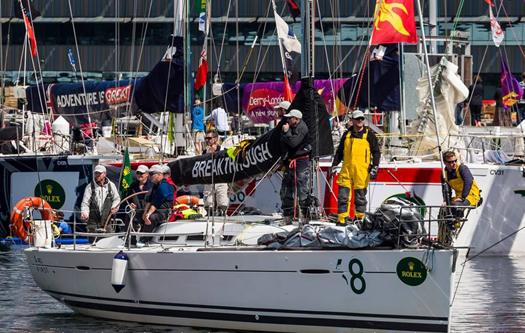
Breakthrough arrives in Hobart. Photo: Carlo Borlenghi/Rolex
Barry Hurley Is Sailor of The Month for October
#sailorofthemonth – Barry Hurley, who learnt his sailing on Cork Harbour out of Cobh, is best known as a star of the short-handed offshore racing scene. But in recent years he has been carving a formidable reputation as a team co-ordinator on board fully-crewed boats, and the recent 606-mile Middle Sea Race out of Malta against a record fleet of more than 120 boats has been an outstanding achievement for him.
In a central role aboard Josef Schultheis's Xp44 XpAct, Hurley and his shipmates took first in class on IRC and ORC, and second overall in both IRC and ORC. It was his tenth Rolex Middle Sea Race, and again it was aboard a boat which as always was immaculately presented, while the gathering of crew from far andwide for XpAct resulted in ten very experienced sailors from five differentcountries coming together in Malta a week before the start.
From Ireland they had Andrew Boyle trimming, a bow team of Kenny Rumball and Phillip Connor, and Barry Hurley as a driver. They opted for four helmsmen, four trimmers, and two bow so as to push hard throughout. Boat preparation had been relentless during the long summer, with the commissioning of a new carbon bowsprit twice the length of the original. They'd a full suit of nine sails to work all the angles to maximise the potency of an already very strong boat, and having finished second in class in 2013 with her, they knew they could do better with a few minor adjustments.
It was a race of two halves. Very light airs for the first three hundred milesgave XpAct the opportunity to recover from some early sail issues , and be in the hunt at the half way point North of Sicily. A strong Mistral then allowed them to push the boat to its limits for the second half, and with non stop trimming in enormous seas they completed the second 300 miles in just over 24hrs. They hit 22.9 knots max boatspeed, and averaged mid teens on the legs to Pantelleria, Lampedusa, and home to Malta, carrying an A3 and one reef in well over 30 knots approaching the finish. The fact that the Volvo70 and some of the other big offshore racing boats only got past them on the last leg shows how hard they were pushing their 44ft 'cruiser racer'.
XpAct's achievement was the peak of a remarkable Irish performance in a challengingevent, with Irish sailors also finishing sixth overall, as well as notching many good placings in individual classes. Next on Barry Hurley's personal agenda is the 70th edition of the Rolex Sydney Hobart Race at Christmas, for which he expects to have Irish sailors in the crew. But for now, he is very definitely the Afloat.ie "Sailor of the Month" for October 2014.
Top Irish Offshore Sailors Eye 70th Sydney–Hobart Yacht Race Prize
#sydneyhobart – Ireland's Barry Hurley, who was part of a winning crew in last month's Middle Sea Race is heading next for The Cruising Yacht Club of Australia's 2014 Rolex Sydney Hobart Yacht Race. The 70th edition is bringing new, old, large and small together for the start on St. Stephen's Day.
Due to the large number and sheer size of some yachts, there will be three start lines this year. The last time numbers topped 100 was in 2004, when 116 boats started, though just 59 finished, the rest unable to withstand the punishing weather of the 60th race.
Sailing with Hurley, who was first in class one in IRC and ORC in the Med, will be INSS's Kenny Rumball along with some other Irish offshore crews on an Australian entry.
Five super maxis, 10 international entries, previous overall and line honours winners, old timers, record breaking boats and people - and the faithful.
One cannot go past two-time treble crown winner and reigning record holder and line honours champion, Wild Oats XI owned by Bob Oatley and skippered by Mark Richards, for line honours. In 2013 they won a protracted battle with Anthony Bell's Perpetual Loyal (former Rambler), allegedly the fastest super maxi in the world.
The two are constantly evolving, undergoing further modifications during the year. Their owners have recruited crews strewn with yachting identities and they will need everything they can muster to take on the other 100 footers in the frame.
Syd Fischer's new Ragamuffin 100. The modified deck of his previous yacht (it took line honours in 2011 under Anthony Bell's ownership) has received a new water ballasted hull. A canting keel completes the picture. Fischer, 87, will tick off his 46th Hobart this year.
Jim and Kristy Hinze Clark's new Comanche (USA) illustrates the latest technology and is the most talked about boat in the fleet. A second American entry is RIO 100 (previously Lahana). Purchased by Manouch Moshayedi, he has lengthened her to 100 feet.
Top Irish Crews Line Out for Malta's Middle Sea Race Tomorrow
#middlesearace – Irish interest in class four of tomorrow's Middle Sea Race in Malta centres on three boats inlcuding last year's winner Otra Vez, a J122 with Ireland's top offshore sailing duo Liam Coyne and Brian Flahive, the August winners of the Round Britain and Ireland race, as part of the hot J-boat crew. Aaron and Edward Gatt Floridia's J122 was the outstanding Maltese entry in last year's race and the first Maltese boat after time correction.
Another top Irish offshore ace Barry Hurley together with dinghy champion,Kenneth Rumball of the Irish National Sailing School, is racing onboard Xpact, an Xp44 in class three.
An Irish team, consisting of three ladies and seven gents, have entered a chartered Dufour 45 under Dublin skipper Cathal Drohan. 'DU4' is in class four for the 600–mile route around Malta and Sicily. Repeat visitor Dermot Cronin's Encore, a First 40.7, is also back for the race in class four.
A Howth Yacht Club team has chartered the Beneteau First 40 'Southern Child', a Bruce Farr-designed cruiser-racer which will race in the IRC 4 class with a rating of 1.083.
HYC team captain Darren Wright and Colm Bermingham will be joined by Howth sailors Kieran Jameson, Frank Dillon, Paul Walsh, Michael & David Wright, Rick De Nieve, Jonny White and Will Murray.
Fellow HYC sailor Laura Dillon will also be competing in the event aboard the Sparkman & Stephens 41 'Winsome'.
This will be the largest fleet ever assembled in the 46 year history of the race. The vast majority of the competing yachts have now registered for the race and about 120 yachts, flying the flags of 24 countries, are set to take on one of the world's most awe-inspiring ocean race courses. Laid end to end, the fleet would form a line of impressive yachts, 1800 metres in length, twice as high as the Burj Khalifa.
Starting and finishing in Malta the 608-mile course around Sicily and its surrounding islands has stunning vistas throughout. The international fleet of yachts will be crewed by an astounding mix of Olympic, America's Cup and round the world sailors, as well as passionate amateur Corinthian sailors. Godwin Zammit. Commodore of the Royal Malta Yacht Club, commented about the success of the Rolex Middle Sea Race.
"The interest in the race has been growing year on year and with entries up over 20% on last year's record entry, the Royal Malta Yacht Club has organised additional berths for competing yachts. In addition to the berths at the Royal Malta Yacht Club, yachts have been accommodated in Grand Harbour and other locations in Malta. Including family and friends of the competing crews, we estimate that well over a thousand people will be visiting Malta for the race. There are many reasons why the race is proving so popular, the Royal Ocean Racing Club has a long association with the race and it is now part of their season's points championship and many of the 18 yachts that have come from Great Britain are doing so for that reason and there is a strong contingent from Italy with 33 yachts visiting from our near neighbour. However, without doubt the most important influence on the success of the race is the prestige and prominence associated with our continued support of Rolex, for which the Royal Malta Yacht Club are extremely grateful."
The hot favourite for Line Honours is Igor Simcic's Maxi, Esimit Europa 2. The European team, led by three-time Olympic Gold medallist Jochen Schumann, will be attempting to take line honours for an unprecedented fourth occasion. Weather permitting, Esimit Europa 2 is capable of beating the course record; 47 hours 55 minutes and 3 seconds. Set by George David's American Maxi, Rambler in 2007.
In IRC 1, there is the mouth-watering prospect of two of the world's best Maxi 72s going head to head. Niklas Zennstrom's Swedish JV72 RAN V and George Sakellaris' American RP72, Shockwave are both crewed by world class professional sailors. Team Ran has won IRC One twice before but Zennstrom's team has never won the race overall. Shockwave will be competing in the race for the first time, George Sakellaris' team was in fine form earlier in the season, winning the RORC Caribbean 600 overall.
In IRC 2 last year's overall winner, Georgio Benussi's TP52, B2 skippered by Michele Galli, returns to defend the title. However, the Italian flyer will first and foremost be focusing on winning a highly competitive class including; Jens Kellinghusen's German Ker 51, Varuna, which won the gruelling Sevenstar Round Britain and Ireland Race and Stefan Jentzsch's brand new hi-tech Carkeek 47, Black Pearl. There are a bevy of yachts in the class which will revel in heavy weather, Vincenzo Onorato's Italian Cookson 50, Mascalzone Latino, German Swan 82, Grey Goose and British Frers 94, Bristolian.
Last year, IRC 3 came to a dramatic conclusion with David Anastasi's J/133, Oiltanking Juno winning the class by under three minutes from Josef Schultheis and Timothy Camilleri's Xp-44, XP-ACT Bank Sails. Both yachts have some of Malta's best sailors on board and will be battling to win again. But IRC 3 is far from a two-horse race. The class of over 25 yachts has strength and depth, including the class winner of the 2014 Cape to Rio Race, Iskareen, co-skippered by Christiane Dittmers and Soenke Bruhns and Class winner of the 2014 RORC Caribbean 600, British Azuree 46 Sleeper, skippered by Jonty Layfield. Rear Commodore of the Royal Malta Yacht Club, Arthur Podesta has competed in every edition of the race and will skipper his First 45 Elusive II BOV.
IRC 4 has over 30 entrants and is arguably the most competitive class. Eric Van Campenhout and Vincent Willemart's MC34, Azawakh has been in outstanding form this year. The Belgian team is currently leading the Royal Ocean Racing Club's Season's Points Championship, in which over 200 yachts have competed, The Rolex Middle Sea Race will be the last race of the series. Azawakh was specially shipped to Malta for the race. GYR Scarlet Oyster is a phenomenally successful yacht, having won class in the Rolex Fastnet Race and RORC Caribbean 600 on numerous occasions. For the Rolex Middle Sea Race, the Oyster 48, GYR Scarlet Oyster will be co-skippered by Ross Applebey and Andy Middleton.
The most successful Maltese yacht of the modern era will be racing in IRC 4. In 2011, Lee Satariano's J/122 Artie, co-skippered by Christian Ripard and with an all-Maltese crew, won the race overall. Artie will be returning to the race course this year with a real chance of winning.
18 yachts will be competing Double Handed, a record for the race. Teams from Croatia, Great Britain, Italy, Malta, Monaco, Netherlands, and Slovenia will take on the gruelling race with just two crew on board. Mikhail Agafontsev's Open 60, Oz is the largest yacht in the Double Handed Class. Alberto de Rossi's Elan 340, Pokekiakkiere, the smallest.
Irish Sailors in the Mix as Light Air Sydney-Hobart Passes Half Way Stage
#rshyc – Irish offshore sailors are in the leading pack of the Sydney-Hobart race today but lack of breeze is leading to tense decisions as Dun Laoghaire sailors onboard the 'Dun Laoghaire entry' Breakthrough, a Beneteau 40 skipered by Barry Hurley, lie sixth overall on IRC handicap. Howth's Gordon Maguire is eighth on Ichi Ban that is chasing for line honours and Adrienne Cahalan a navigator with strong Irish connections, sailing in her 22nd race is 46th on IRC. The Clipper yacht entry Derry-London Derry skippered by Sean McCarter is 65th on IRC in the 92 boat fleet. Live race tracker here.
Twenty-four hours after the Rolex Sydney Hobart fleet raced out of Sydney Harbour the pace slowed up as the lead boats picked their way down the southeast coast of Australia.
Also on board Breakthrough is Irish Fireball champion Kenny Rumball, (Watch Leader), Keith Kiernan (Navigator & Radio man), Catherine Halpin (Bow-Woman) all members of the Royal Irish Yacht Club.
Meanwhile, a navigator with strong Irish connections, Adrienne Cahalan is sailing in her 22nd race – but after eight years on the 100-foot Wild Oats XI, the accomplished offshore navigator is shifting gears and stepped onto a boat close to half the size: Bill Wild's 55-footer, Wedgetail.
This morning Cahalan emailed, "It was busy last night – lots of sail changes as we headed south through clouds coming from shore. We were in close contact all night with Ichi Ban, Varuna, Nikata, Victoire and Zefiro.
"The wind is so light out here now that if you did not position your boat last night for today, it is probably too late now. Having said that the fleet is close together today near us and appear to be following the same strategy, unlike last night when some boats when right inshore and some, like us, chose to stay further offshore. The wind won't fill in from the north until later today for us, so we are patiently waiting."
Overnight, Anthony Bell's Perpetual Loyal made the strategic move to head further offshore than her main rival, Bob Oatley's six-time line honours winner, Wild Oats XI. Loyal's strategy worked as they eked out a gain of close to 14 nautical miles, surprising given pre-race the boat was touted as favouring heavier airs.
By midday today (December 27) however, Wild Oats XI reeled in Loyal and took a slight lead. Just ten miles back was Syd Fischer, sailing in his 45th Sydney Hobart, this time on Ragamuffin 100, newly fitted out with water ballast and daggerboards – and as of this afternoon, leading IRC Division Zero on handicap.
The weather forecast will be the game changer for all of the fleet as they sail down the coast. Rachel McInerney, Duty Forecaster for the Bureau of Meteorology in Hobart reported earlier today, "Currently through Bass Strait there are light southwesterly winds, which will weaken as a ridge of high pressure west of Tasmania moves east. Winds will become light and variable overnight and then a north-northeasterly flow will develop through tomorrow morning; this will freshen the further down the east coast they go.
"Expecting northeast winds to become strong Saturday afternoon (Dec 28), 20-30 knots along lower east coast (15-25 upper east coast). A westerly change is expected Saturday evening which could cause some issues with winds turning around west-southwest, quite strong, up to gale-force along the south coast."
Approximately 80 nautical miles behind Wild Oats XI, is Matt Allen's Carkeek 60, Ichi Ban, currently leading IRC Division 1 on handicap. Helmsman on board Ichi Ban is Howth's Gordon Maguire. Will Oxley, navigator onboard, reported earlier, "We're just hanging on the coat tails of some of the big boats. Looks like a tricky day, and we are hoping to hold onto favourable northeast winds as long as possible. All is going to game plan, except for thunderstorms inshore last night, which slowed the fleet a bit."
Adrienne Cahalanis sailing in her 22nd race – but after eight years on the 100-foot Wild Oats XI, the accomplished offshore navigator is shifting gears and stepped onto a boat close to half the size: Bill Wild's 55-footer, Wedgetail.
As of 4:00pm AEDT, the bulk of the fleet was between Eden and Uladulla, almost all boats east of the rhumbline, up to 70 nautical miles offshore.
As the frontrunners entered Bass Strait mid-afternoon today they were sailing in a light southwesterly making less than 10 knots of boat speed, in four knots of wind. With the race record for line honours no longer in threat, the ETA for the big boats at the finish off Hobart is more likely Saturday evening. Nonetheless, with 300+ nautical miles to the go, the battle is far from over. The lack of breeze is frustrating and challenging. Anthony Bell, skipper of Perpetual Loyal said, via Skype this afternoon, "Don't know if you want to be the frontrunner going into Tasman Island; as long as we stay in touch and stay within striking distance...we're staying positive, and the guys are working hard to keep the boat going."
Ninety-two boats are still racing, with two boats retired shortly after the start yesterday; Audi Sunshine Coast with damage to her rig, and Dodo with mainsail damage.
Could Ireland Bid for Solo Race Across the Atlantic?
#ostar – Could Ireland's location be an advantage to any bid to win the rights to stage the the original solo race across the North Atlantic? The next edition of 'The Transat', the original solo race across the North Atlantic that was born as the OSTAR, will start in its historical time slot in May 2016 from the UK to North America but aftet that race the race start location is open to bidders. Is this a new opportunity for Ireland's former Volvo Ocean Race city, Galway to consider?
Start and finish host cities will be invited in January to put their case forward for hosting this event that is both steeped in history, and that helped create a sector of sailing that is now one of the major forces in the professional sport. Traditionally, The Transat has started from the iconic sea-faring port of Plymouth in the UK and finished in the USA. In New York in the first edition in 1960, then Newport, Rhode Island in the intervening years, before Boston became the arrival port in the last two editions in 2004 and 2008.
In 2009, Ireland's Barry Hurley and Italian sailor Luca Zuccoli had an exciting match-race to the OSTAR finish line in Newport, with Barry hugging the shore line (a trick learned from his years sailing in Cork Harbour) and crossing the line literally just minutes ahead after 21 days at sea. The result put him first over the line in his class, and also first on IRC corrected time.
OC Sport renamed the race 'The Transat' in 2004, and added Artemis as Title Partner in 2008, focusing in that year on the IMOCA 60 Class, the boats that compete in the Vendee Globe in the same year. The 2012 edition was deferred at the request of the Class.
With the next edition of The Transat planned for May 2016 in its traditional pre-Vendee Globe slot, consideration is now also being given to the classes that could be invited to compete.
When OC Sport acquired the rights to the race in 2004, it was determined to serve the needs of the professional end of the sport, whilst the Royal Western Yacht Club continued to run a Corinthian race for non-professional sailors restricted to boats of up to 50 feet. The 2004 edition was open to 50ft monohulls and the IMOCA class (60ft monohulls) and the ORMA class (60ft multihulls). In 2008, with the demise of the ORMA class, entry was restricted to the IMOCA class and the Class 40 only. The decision on classes invited to participate will be taken by December 2014.
Hurley Scoops October Sailor Title
#sailorofthemonth – Barry Hurley is the Afloat.ie/Irish Independent October "Sailor of the Month" to mark his victory last weekend in the two-handed division in the 606-mile Rolex Middle Sea Race out of Malta with his JOD 35 Dinah.
Hurley (32), originally from Cobh, had a very capable shipmate with him in the form of Andrew Boyle, who has raced several times on major events as the No 2 on Dinah. But the adjudicators felt that as it was Barry Hurley's dedication and determination which ensured that Dinah was in full racing trim and ready to go in the record fleet in this year's Mediterranean marathon, the success was primarily his personal achievement.
He has been Sailor of the Month before, back in June 2009 when he won his class with the same boat in the Single-Handed Transatlantic Race. In fact, single handed racing is very much his thing – back in June this year, when the Irish sailing community was mainly focused on the Round Ireland Race, three boats raced out of Galway on the inaugural 750-mile Round Rockall Race, and Dinah with Hurley won the two boat solo division from Jamie Young of Mayo in the Frers 49 Killary Flyer.
For most sailors, battling out round Rockall would be enough for any one season. But Dinah's owner-skipper has shown his determination by getting his boat out to the Med and ready to race in what is now firmly established as Malta's primary annual maritime event. Indeed, at the prize giving, Malta's Tourism Minister Mario de Marco described it as Malta's most prestigious international event full stop.
This time round, 83 boats crossed the starting line, and after a race plagued by light winds, but with a mighty thunderstorm which provided more than enough wind for one section of the fleet, the overall winner was the Welbourn 46 Hi Fidelity (Eddie de Villiers, South Africa).
The five boats in the two-handed division went right down to the wire, as the race has a seven day time limit, and though Hurley and Boyle knew they were in with a shout for their class win as they came towards the finish line last Saturday, in the end they only had 25 minutes to spare before time ran out.
For Hurley, it was "the most intense" race he has ever sailed. The Irish ambassador to Malta, Jim Hennessy, was there with supporters to welcome them in to an emotional finish as they beat the clock by that crucial 25 minutes, which enabled them to take a clear corrected time win of six hours in the two-handed division.
Hurley & Boyle Win Double Handed Middle Sea with Only Minutes to Spare (Podcast Here!)
#middlesearace – There were emotional scenes dockside in Malta this morning as Irish sailors Barry Hurley and Andrew Boyle sailed home in their 35-yacht Dinah to win the double handed class, they finished just 25 minutes inside the time limit after seven days of tense racing in the Rolex Middle Sea Race.
Hurley has described the race as the 'most intense' race he has ever sailed due to the stop start nature of the winds. In an exclusive podcast (below) by Afloat correspondent Louay Habib, Hurley admits there was 'real pressure' over the last few hours. The overall achievement has yet to sink in for the Dun Laoghaire pairing but it has not stopped early celebrations this morning that has made sailing the boat 3000 miles from Dun Laoghaire to Malta a really worthwhile conclusion to the 2012 season.
Only last night the pair were judged as outsiders to finish the race at all such has been the fickle conditions for the 33rd race but a favourable wind overnight allowed Hurely and Boyle to pick up seeds of 17 knots at times to cover 120 miles in 12 hours.
The Mediterranean odyssey ended with an official welcome home from Irish Ambassador Jim Hennessy who was waiting to welcome the Royal Irish Yacht Club boat and celebrate yet another international victory for the offshore sailing champions.

The crew of Dinah and Atame share a beer and a few stories dockside after tying up at The Royal Malta Yacht Club. The two teams had been locked in combat for 7 days and nights. L-R Beppe Bisotto, Barry Hurley, Ian Knight and Andrew Boyle Photo: Royal Malta Yacht Club/Louay Habib
Hennessy who held a pre-race reception for the Irish crews in Malta was also first to congratulate the pair on stepping ashore. 'It's a really gutsy performance that has defied a lot of the experts here in Malta. We're really proud of them, it's a great win, he told Afloat.ie as he held the tricolour aloft with the crew at the Royal Malta Yacht Club.
There was other Irish involvement in the race from Dun Laoghaire yacht Gallileo skippered by Des Keliher. The Beneteau 44.7 yacht retired due to the light winds on Tuesday but there has been Irish interest in at least two other international entries in the 83-boat fleet.
Fireball dinghy champion Kenny Rumball also from Dun Laoghaire was aboard German entry Kohinoor, a Carter 55 Custom Sloop and Irish sea offshore campaigners Liam Coyne and Brian Flahive was racing on the Maltese J122 entry Otra Vez.
As well as Irish boats heading to the Med for racing Ambassador Hennessy says he is keen to create a 'two way movement of boats' and is hopeful that Maltese boats with Irish sailors aboard will head north next year for 'The Gathering'.






























